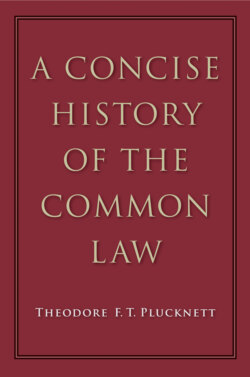Читать книгу A Concise History of the Common Law - Theodore F. T. Plucknett - Страница 133
На сайте Литреса книга снята с продажи.
THE NEXT OFF-SHOOT: THE COURT OF COMMON PLEAS
ОглавлениеWe have already mentioned the very numerous Eyres which took place during Henry II’s reign. Indeed the popular complaint was that there were too many of them, and in 1178 we find a remarkable passage in a chronicler4 which tells us that—
“While he was staying in England, the King enquired whether the justices whom he had set up in England had treated the people fairly; and when he learned that the country and the people were much aggrieved by the number of justices (for there were eighteen of them), by the advice of the wise men of his realm he chose five only, two clergy and three laymen, all of his personal household, and decreed that these five should hear all the complaints of the realm, and do right, and not depart from the King’s court but remain there to hear the people’s complaints. And if any question should arise among them which they could not solve, they were to bring it up in the royal hearing for determination according to the pleasure of the King and the wiser men of the realm.”
The current interpretation of this passage, first suggested by Maitland and later modified by Pike and Adams, is that in 1178 Henry II by a deliberate act established a new court, which in later times became known as the Court of Common Pleas. Adams1 insists that the powers of this court, like those of its descendant, the later Court of Common Pleas, were strictly limited, and that it was expressly debarred from exercising that wide discretion which was the privilege of the Curia Regis. The “limitations”, however, were not of the sort we would associate to-day with the expression “limited jurisdiction”. As Holdsworth points out, in criticising Adams’ view, the new court in fact entertained every sort of business (including occasional pleas of the crown).2 The situation seems best described as the effective, but informal, subordination of the new justices to the king and his court of “wiser” men, rather than limitation to a precise list of powers. Its foundation was suggested by the experience of the Justices in Eyre, and was designed to render available all the time the judicial advantages of the intermittent or occasional Eyre, while, on the other hand, the high-handed action of certain of those justices was to be prevented by subjecting the new court to the supervision of the king’s council and by confining it within the limits of a procedure which was soon to become comparatively strict. The result was to give the public access to royal justice which was no longer mingled with the financial functions of the Eyre. The fact that this body of judges was erected as a separate court3 was not allowed to stand in the way of practical convenience, however, and if for any reason it became desirable to move a case backwards and forwards between the newly erected court and the body which met around the king himself, then there was nothing to prevent such a course. This event of 1178 must not be regarded as a sudden creation of a new court by an act of legislation, but rather as the culmination of a number of earlier experiments,4 which all had the general characteristic of subjecting the itinerant justices to the limitations set out in their commissions or instructions.1
Maitland discerned signs in the middle of the twelfth century of an old oral and traditional formalism,2 which by the end of the century has developed into a written and authoritative formalism—the writ-system of the common law which Glanvill described in some detail; and, as Professor Baldwin remarks, such limitations are appropriate to the new body of 1178, and not to the Curia Regis itself.
“It must be understood that the so-called formulaic and restrictive procedure began, and could begin, only in the courts held by the royal commissioners—that is, first by the itinerant justices and then the central court established on similar lines.”3
It was a notable feature of the new arrangement of 1178 that the justices were to remain with the King; that necessarily meant perpetual perambulation. On the other hand, the “chief court”, capitalis curia, whose practice is the subject of Glanvill’s treatise (written soon after 1187), seems fairly fixed at Westminster. Professor Sayles expresses a doubt whether the five justices of 1178 are indeed the same institution as that which Glanvill described, and suggests that the latter may be “a different creation”. It may be; there were indeed many “creations”. The difficulty largely disappears when one remembers that these “creations” were casual, temporary expedients, with no similarity to a “creation” of a court by a modern act of parliament. The repetition of these expedients slowly resulted in an institution, and its settlement at Westminster naturally resulted from Henry II’s absence abroad, which made it impossible to stay with the king and at the same time to hear the complaints of the realm. A generation later Magna Carta was to fix the Court of Common Pleas permanently at Westminster.4 The second administrative routine to become an institution is therefore largely a judicial one, and, after a period of experiment in the Eyres, it finally developed into the Court of Common Pleas, or “The Bench” as the older books call it.
